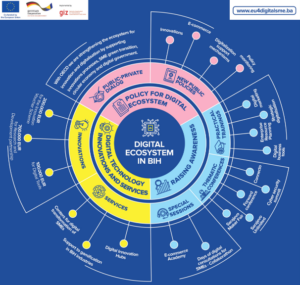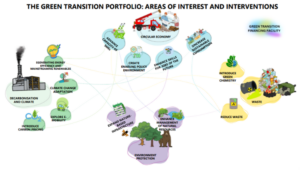The 6th Annual conference on SME development support in BiH opened the question of how to achieve a greater impact of international projects on the dynamics of change in companies and the economy of BiH in the direction of smart growth and sustainable development. The common goal is to move from the effects of individual projects to a systemic effect (creating an ecosystem for smart growth and sustainable development of SMEs), while achieving a synergistic effect (greater than the sum of the effects of individual projects). This means introducing changes in the approach of donors and projects, both in terms of designing and implementing interventions, and in terms of their mutual coordination.
The main question was considered from three main perspectives: the increasingly dominant international perspective of SME business and the innovation challenges they face, the dominant patterns in implementing changes and improvements in domestic SMEs, and the perspective of implementers of international projects supporting SME development in BiH. In this blog, we will try to summarize the main insights gained from each of these perspectives. The possibilities of their synthesis and digging deeper will be left for another, hopefully soon, opportunity.
Dr. Shawn Cuningham, a long-time advisor to Eda and an international expert on innovation and improving the competitiveness of the private sector, opened the first, international perspective. He vividly presented the challenge we face: how to facilitate our companies (which compete, not only with other companies but also against their dynamic networks supported by public, private, and social/network innovations) to climb ‘out of the valley’ of individual, isolated innovation, ‘to the hill’ from where they can see further and wider.
To achieve this, it is necessary to strengthen the (joint) capability to purposefully reshape the local ‘landscape’ in which SMEs operate, by moving from supporting individual innovations to the level of social or network innovation. In this context, various stakeholders innovate the ways they collaborate, share information, and collectively make sense of complex, ambiguous situations and conditions of uncertainty. In the case of projects, as well as support institutions and companies, this means transitioning from the dominant pattern of individual, often isolated action to collective action in solving difficult problems that are often unsolvable through individual efforts.
Jelena Prohaska, a senior researcher and advisor at Eda, partially opened the second perspective, by presenting the initial results of a SenseMaker study on changes and improvements in businesses in BiH.
These results show that currently in the introduction of innovations, the ‘internal’ perspective (focus on efficiency, cost reduction, desire to improve own performance) dominates over the ‘external’ view (market opportunities, attention to clients). This largely closed perspective is probably conditioned by two factors: (1) the position in international value chains, where export-oriented SMEs are required to constantly ‘tighten’ their production; and (2) a weak domestic institutional environment that does not enable companies to move towards more ambitious innovations in terms of products and business models.
This pattern and its background demonstrate a high level of coherence with risk management and the use of funding sources when introducing improvements. The majority of companies that shared their stories faced overloading their own resources or capacities (technical and financial), most of them used their own funds to finance these investments, a somewhat smaller number combined this with grant funds, and a very small number utilized credit resources. Along with external constraints (limited availability of higher-quality professional staff, absence of newer financial arrangements such as venture capital investment), serious internal limitations can be assumed in terms of the availability and quality of professional staff, as well as the quality of financial management in the companies.
The perspective of project support gradually took shape through two panel discussions involving leaders of current projects (Ismar Ćeremida – UNDP, Donald Prohaska – GIZ, and Goran Janković – Eda), experts who have led successful projects (Željko Karanović, Zihnija Hasović, Mirza Kušljugić), Ognjenka Lalović as a representative of the FCC BiH, an association that is often a domestic partner in international projects, and Marina Dimova, who is working on introducing a new, portfolio approach at UNDP BiH.
Here are some of the limitations and possible ways of overcoming them, highlighted during the panel discussions:
- Limitations inherent to the project approach, especially in terms of requirements to predefine all or the main elements of project execution, because it is impossible to know in advance what is needed, and because things that affect the progress and results of the project change. A more rigid approach demands that practically everything important for future action be predefined, from the starting situation to the goals, expected outcomes, indicators, activities, and resources… while a more flexible approach allows the implementer to adapt activities and resources to the set goals and outcomes.
- Recently, attempts have been made to overcome the limitations of the project approach by shifting from individual projects to programs with coordinated projects within them (GIZ), or by moving to a portfolio approach (UNDP).
- Limitations in defining problems, the predominance of a linear approach in planning and executing project interventions, limited resources, and the short duration of projects and their outputs, insufficient cooperation between projects… An excellent overview of these limitations and possibilities for overcoming them is given in the blog by colleague Goran Janković, titled “Complexity as a Challenge and Networking as Part of the Response.”
- Shifting from targeting “more jobs” to “better jobs” and the fuller inclusion of support institutions at the meso level in planning and executing project interventions, in order to fulfill their role in strengthening systemic competitiveness.
There was also discussion about weaknesses in the approach of companies that hinder better project performance: owners of small businesses are often also their directors and frequently represent a “bottleneck” in defining and providing better support; companies are too focused on the short-term dimension of business and do not show readiness to participate more seriously and to change… It was also noted that the business sector, however, changes faster than the public sector and support institutions.
A unanimous view is that international development partners and projects can play a key role in strengthening the dynamics of change (innovations) in both enterprises and the public sector and other support institutions. To actually do this and help strengthen the (joint) capability to purposefully reshape the “landscape” in which SMEs operate, they need to significantly innovate their approach, focuses, time frame, means, and mode of operation, starting from the position that the challenges faced by all these actors are opportunities for joint learning of lessons that are difficult, but necessary and urgent.













